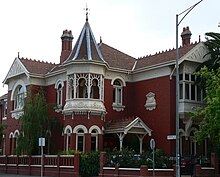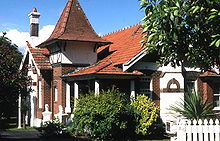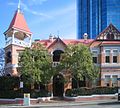Queen Anne style architecture

Winslow Hall in Buckinghamshire, 1700 and probably by Christopher Wren, has most of the typical features of the original English style

Bluecoat Chambers in Liverpool, of 1717, in a version of the original Queen Anne style
The Queen Anne style in Britain refers to either the English Baroque architectural style approximately of the reign of Queen Anne (reigned 1702–1714), or a revived form that was popular in the last quarter of the 19th century and the early decades of the 20th century (when it is also known as Queen Anne revival).[1] In British architecture the term is mostly used of domestic buildings up to the size of a manor house, and usually designed elegantly but simply by local builders or architects, rather than the grand palaces of noble magnates. Contrary to the American usage of the term, it is characterised by strongly bilateral symmetry with a Italianate or Palladian-derived pediment on the front formal elevation.
The architectural historian Marcus Binney, writing in The Times in 2006, describes Poulton House built in 1706, during the reign of Queen Anne, as "...Queen Anne at its most delightful". Binney lists what he describes as the typical features of the style:[2]
- a sweep of steps leading to a carved stone door-case
- rows of painted sash windows in boxes set flush with the brickwork
- stone quoins emphasizing corners
- a central triangular pediment set against a hipped roof with dormers
- typically box-like "double pile" plans, two rooms deep
When used of revived "Queen Anne style" of the 19th and 20th century the historic reference in the name should not be taken too literally, as buildings in the Queen Anne style often bear as little resemblance to English buildings of the 18th century as those of any revival style to the original. Furthermore, the Queen Anne style in other parts of the English-speaking world, particularly in the United States and Australia, is significantly different from that in the United Kingdom, and may hardly include any elements typical of the actual architecture of Anne's reign.
Contents
1 British 19th-century Queen Anne style
2 American Queen Anne style
3 Australian Queen Anne style
4 Gallery
5 See also
6 References
7 Further reading
8 External links
British 19th-century Queen Anne style
George Devey (1820–1886) and the better-known Norman Shaw (1831–1912) popularized the Queen Anne style of British architecture of the industrial age in the 1870s. Norman Shaw published a book of architectural sketches as early as 1858, and his evocative pen-and-ink drawings began to appear in trade journals and artistic magazines in the 1870s. (American commercial builders quickly adopted the style.)
Shaw's eclectic designs often included Tudor elements, and this "Old English" style also became popular in the United States, where it became known (inaccurately) as the Queen Anne style. Confusion between buildings constructed during the reign of Queen Anne and the "Queen Anne" style still persists, especially in England.
In the late 1850s the name "Queen Anne" was in the air,[citation needed] following publication in 1852 of William Makepeace Thackeray's novel, The History of Henry Esmond, Esq., A Colonel in the Service of Her Majesty Queen Anne. One minor side-effect of Thackeray's novel and of Norman Shaw's freehand picturesque vernacular Renaissance survives to this day. When, in the early 1870s, Chinese-inspired Early Georgian furniture on cabriole legs, featuring smooth expanses of walnut, and chairs with flowing lines and slat backs began to be looked for in out-of-the-way curio shops (Macquoid 1904), the style was mis-attributed to the reign of Queen Anne, and the "Queen Anne" misnomer has stuck to this day, in American as well as English furniture-style designations. (Even the most stylish and up-to-date furnishings of the historical reign of Queen Anne, as inventories reveal, used a style that 21st-century connoisseurs would immediately identify as "William and Mary".)
The British Victorian version of the style empathises more closely with the Arts and Crafts movement than does its American counterpart. A good example is Severalls Hospital in Colchester, Essex (1913–1997), now defunct. The historic precedents of the Queen Anne style were broad:
- fine brickwork, often in a warmer, softer finish than the Victorians characteristically used, varied with terracotta panels, or tile-hung upper stories, with crisply-painted white woodwork, or blond limestone detailing
oriel windows, often stacked one above another- corner towers
- asymmetrical fronts and picturesque massing
- Flemish mannerist sunken panels of strapwork
- deeply shadowed entrances
- broad porches
- overall, a domesticated free Renaissance style

County Hall, Wakefield, designed by architects James Glen Sivewright Gibson and Samuel Russell in 1894
When an open architectural competition took place in 1892 for a county hall to be built in Wakefield, in the West Riding of Yorkshire, the instructions to competitors noted that "the style of architecture will be left to the competitors but the Queen Anne or Renaissance School of Architecture appears suited to an old town like Wakefield".[3] The executed design, by architects James Gibson and Samuel Russell of London, combines a corner turret, grandly domed and with gargoyles at the angles, freely combined with Flemish Renaissance stepped gables.
In the 20th century Edwin Lutyens and others used an elegant version of the style, usually with red-brick walls contrasting with pale stone details.
American Queen Anne style

The Carson Mansion, located in Eureka, California, is widely considered to be one of the highest executions of American Queen Anne style.
In the United States, the so-called "Queen Anne style" is loosely used of a wide range of picturesque buildings with "free Renaissance" (non-Gothic Revival architecture) details rather than of a specific formulaic style in its own right. "Queen Anne", as an alternative both to the French-derived Second Empire and the less "domestic" Beaux-Arts architecture, is broadly applied to architecture, furniture and decorative arts of the period 1880 to 1910; some "Queen Anne" architectural elements, such as the wraparound front porch, continued to be found into the 1920s.
The gabled and domestically scaled "Queen Anne" style arrived in New York City with the new housing for the New York House and School of Industry Sidney V. Stratton, architect, 1878). Distinctive features of American Queen Anne style (rooted in the English style) may include an asymmetrical façade; dominant front-facing gable, often cantilevered out beyond the plane of the wall below; overhanging eaves; round, square, or polygonal tower(s); shaped and Dutch gables; a porch covering part or all of the front facade, including the primary entrance area; a second-story porch or balconies; pedimented porches; differing wall textures, such as patterned wood shingles shaped into varying designs, including resembling fish scales, terra cotta tiles, relief panels, or wooden shingles over brickwork, etc.; dentils; classical columns; spindle work; oriel and bay windows; horizontal bands of leaded windows; monumental chimneys; painted balustrades; and wooden or slate roofs. Front gardens often had wooden fences.
[4]
Australian Queen Anne style

Queen Anne styled mansion located in South Yarra, Victoria.
In Australia, the Queen Anne style was absorbed into the Federation style, which was, broadly speaking, the Australian equivalent of the Edwardian style, derived from the influence of Richard Norman Shaw,[5] an influential British architect of the late Victorian era. The Federation period went from 1890 to 1915 and included twelve styles, one of which was the Federation Queen Anne. This became the most popular style for houses built between 1890 and 1910.[6] The style often utilised Tudor-style woodwork and elaborate fretwork that replaced the Victorian taste for wrought iron. Verandahs were usually a feature, as were the image of the rising sun and Australian wildlife; plus circular windows, turrets and towers with conical or pyramid-shaped roofs.

'Vallambrosa', a Queen Anne Style house located at 19 Appian Way in the Sydney suburb of Burwood
The first Queen Anne house in Australia was Caerleon in the suburb of Bellevue Hill, New South Wales.[7] Caerleon was designed initially by a Sydney architect, Harry Kent, but was then substantially reworked in London by Maurice Adams.[8] This led to some controversy over who deserved the credit. The house was built in 1885 and was the precursor for the Federation Queen Anne house that was to become so popular.
Caerleon was followed soon after by West Maling, in the suburb of Penshurst, New South Wales,[9] and Annesbury, in the suburb of Ashfield, New South Wales, both built circa 1888. These houses, although built around the same time, had distinct styles, West Maling displaying a robust Tudor influence that was not present in Annesbury. The style soon became increasingly popular, appealing predominantly to reasonably well-off people with an "Establishment" leaning.[10]
The style as it developed in Australia was highly eclectic, blending Queen Anne elements with various Australian influences. Old English characteristics like ribbed chimneys and gabled roofs were combined with Australian aspects like encircling verandahs, designed to keep the sun out. One outstanding example of this eclectic approach is Urrbrae House, in the Adelaide suburb of Urrbrae, South Australia, part of the Waite Institute. Another variation with connections to the Federation Queen Anne style was the Federation Bungalow, featuring extended verandahs. This style generally incorporated familiar Queen Anne elements, but usually in simplified form.
Some prominent examples are:[11]
West Maling, corner of Penshurst Avenue and King Georges Road, Penshurst, Sydney
Homes, Appian Way, Burwood, Sydney
Homes, Haberfield, New South Wales
Caerleon, 15 Ginahgulla Road, Bellevue Hill, Sydney (sold for $22 million in January 2008)[12]
Annesbury, 78 Alt Street, Ashfield, Sydney
Weld Club, Barrack Street, Perth
ANZ Bank, Queens Parade, Fitzroy North, Melbourne
Campion College, Studley Park Road, Kew, Melbourne
Redcourt Estate, Armadale, Melbourne
Tay Creggan, Hawthorn, Melbourne
Gallery

West Maling, Penshurst NSW

'Amalfi', 2 Appian Way Burwood NSW

'Vallambrosa' 19 Appian Way Burwood NSW
Burwood Appian Way

The Manse Haberfield Federation style house

Caerleon, Bellevue Hill, Sydney NSW

Weld Club, Perth WA

Queen Bess Row in East Melbourne

Federation terraces. Park Street, South Yarra

Redcourt, Armadale, Victoria, Australia

Edzell Mansion, Toorak Victoria

Elmcroft, Smiths Falls, Ontario
See also
- Category: Queen Anne architecture
- Category: Queen Anne architecture in the United States
- Queen Anne style furniture
- Revivalism (architecture)
- Shingle Style architecture
References
^ Cambridge Encyclopedia, Crystal (Cambridge University Press) 1994, p.69
^ The Times, "Bricks and Mortar" Supplement, 5 May 2006, pp.6-7.
^ County Council Records, 11 January 1893; Papers Building of County Hall
^ Queen Anne Style
^ A Pictorial Guide to Identifying Australian Architecture, Apperly (Angus and Robertson) 1994, p.132
^ A Pictorial Guide to Identifying Australian Architecture, p.132
^ The Federation House, Hugh Fraser (New Holland) 2002, p.24
^ Sydney Architecture, Graham Jahn (Watermark Press) 1997, p.62
^ Heritage branch | NSW Environment & Heritage
^ The Federation House, p.22
^ A Pictorial Guide to Identifying Australian Architecture, pp.132-135
^ Sydney Morning Herald, January 25th 2008, page 3
Further reading
Girouard, Mark, Sweetness and Light: The Queen Anne Movement, 1860–1900, Yale University Press, 1984. The primary survey of the movement.- Macquoid, Percy, Age of Walnut, 1904.
The Shingle Style and the Stick Style: Architectural Theory and Design from Downing to the Origins of Wright, revised edition, Yale University Press, 1971.- Rifkind, Carole. A Field Guide to American Architecture. Penguin Books, New York, 1980.
- Whiffen, Marcus. American Architecture Since 1780. MIT Press, Cambridge, Massachusetts, 1999.
External links
| Wikimedia Commons has media related to Federation Architecture of Australia. |
- Photography of Queen Anne Style Homes in Hamilton, Ontario
- Federation Queen Anne Style
- Gothic Queen Anne Style













